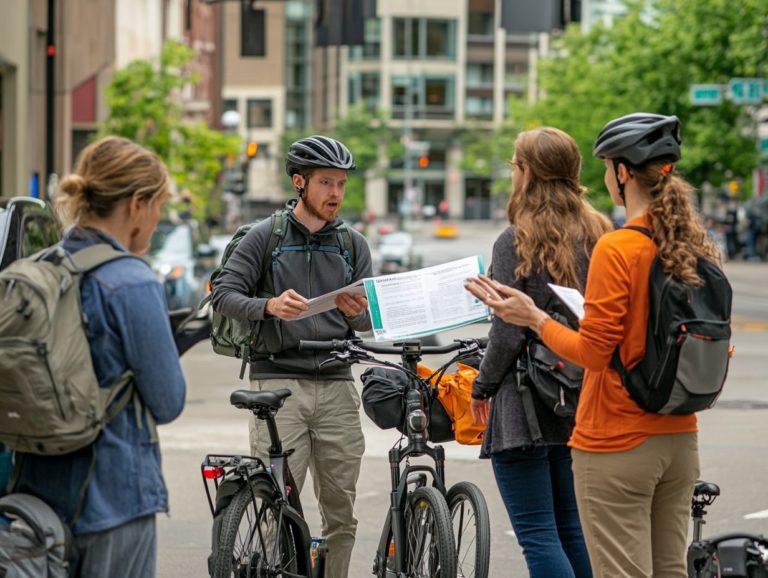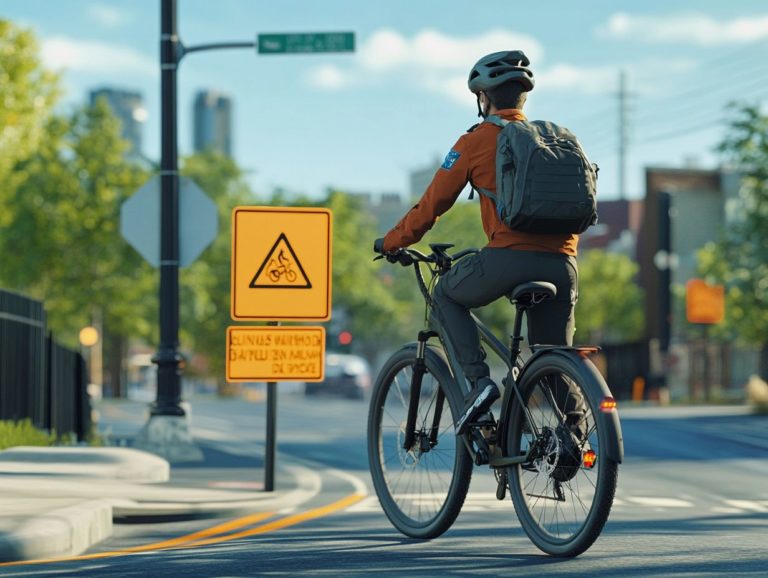Electric Bicycle Regulations: A Resource for Cyclists
With e-bikes booming in popularity, you must understand the electric bicycle laws and regulations that govern these bikes. This article delves into local and national regulations, including e-bike classifications, various types of electric bicycles, and essential safety tips to ensure a secure ride.
You’ll discover the environmental and health benefits of electric biking, along with valuable resources tailored for e-bike riders. Immerse yourself in this exploration to elevate your riding experience and navigate this thrilling landscape with confidence!
Contents
- Key Takeaways:
- What are Electric Bicycles?
- Understanding the Laws and Regulations
- Types of Electric Bicycles
- Safety Considerations for Electric Bicycles
- Benefits of Electric Bicycles
- Resources for Electric Bicycle Riders
- Frequently Asked Questions
- 1. What is an electric bicycle and how is it different from a regular bicycle?
- 2. Do electric bicycles have different regulations than regular bicycles?
- 3. What are the speed limits for electric bicycles?
- 4. Are there age restrictions for riding an electric bicycle?
- 5. Are electric bicycles allowed on bike paths and trails?
- 6. Do I need a license to ride an electric bicycle?
Key Takeaways:
- Join the exciting trend of electric bicycles! It’s important for cyclists to be aware of the laws and regulations surrounding them.
- Electric bicycles come in different types, each with unique classifications and features, so it’s crucial to know which type is allowed in your area.
- Riding an electric bicycle involves safety considerations, such as wearing a helmet and following traffic laws. However, they also offer environmental and health benefits compared to traditional bicycles.
What are Electric Bicycles?
Electric bicycles, or e-bikes, represent a brilliant fusion of traditional cycling and electric power, elevating your riding experience to new heights. These remarkable machines come equipped with components that help you pedal, making them ideal for a range of terrains and riding styles. Whether you’re a casual commuter or a dedicated cyclist, e-bikes offer a compelling alternative to conventional transportation while promoting a healthier lifestyle and sustainability.
E-bikes can be categorized into several types, including pedal-assist (bikes that help you pedal) and throttle-controlled models, as well as low-speed electric bicycles. Each type provides unique advantages, allowing you to cover longer distances and conquer steeper hills with remarkable ease.
The benefits of e-bikes extend to reduced commuting times, lower transportation costs, and a significantly smaller carbon footprint compared to gas-powered vehicles. This highlights their appeal as part of the shift to active transportation. As awareness of environmental impacts grows, the popularity of low-speed electric bicycles has surged, attracting those who desire eco-friendly options for navigating urban landscapes.
This trend reflects a broader societal shift towards sustainable practices, facilitating a healthier lifestyle while tackling congestion and pollution in our cities.
Understanding the Laws and Regulations
The legal landscape surrounding electric bicycles is in a state of constant flux, characterized by a myriad of state laws and e-bike regulations emerging at local and national levels to promote safety and standardization.
Understanding these regulations is crucial as you navigate the intricate web of electric bicycle laws, which can vary widely from state to state. This is particularly true concerning classifications such as Class 1 (e-bikes that provide assistance only when you pedal), Class 2 (e-bikes with a throttle), and Class 3 (e-bikes that assist up to higher speeds). For those new to the world of e-bikes, referring to an electric bicycle buying guide for beginners can provide valuable insights. These classifications are defined under federal standards by the Consumer Product Safety Commission.
Organizations like PeopleForBikes play a vital role in advocating for favorable electric bike legislation. Events like the Electric Bicycle Summit ensure that your rights and interests as an e-bike rider are well represented.
If you want to learn more about e-bikes and stay informed about local regulations, check out resources available in your area!
Local and National Regulations
Local and national regulations play a crucial role in governing the use of electric bicycles. They ensure you are fully aware of your rights and responsibilities while riding.
These regulations outline important details, such as permissible speeds, designated riding areas, and necessary equipment based on your e-bike classification whether it’s Class 1, Class 2, or Class 3. For more information on the different classifications, check out this guide on electric bicycle types. This legal framework is essential for creating a safe environment for all road users.
For example, in California, regulations allow Class 1 and Class 2 e-bikes to ride on bike lanes. In contrast, New York City enforces strict rules regarding how and where different classes can be used. To learn more about this topic, check out our beginner’s guide to electric bicycle types. This reflects the varied e-bike legislation across the United States.
Such variations can significantly influence your behavior as a rider. In areas with more lenient regulations, you might feel encouraged to use your e-bike for commuting. This can lead to heightened safety awareness and responsible riding habits.
On the flip side, strict restrictions can deter you, potentially making you less experienced and more hazardous to yourself and others. Knowing these differences is key to enjoying your e-bike adventures!
Types of Electric Bicycles
Electric bicycles fall into three primary classifications Class 1, Class 2, and Class 3 each distinguished by their level of motor-assisted speed and specific features.
Class 1 e-bikes offer assistance solely when you re pedaling, ensuring a more traditional cycling experience. Class 2 e-bikes provide throttle assistance, allowing you to engage the motor without pedaling at all.
Meanwhile, Class 3 e-bikes can reach higher speeds and often come with additional regulations. Understanding this classification system is crucial for you as a rider, as it highlights the capabilities and limitations of your e-bike.
This knowledge ensures you make informed choices on your journeys.
Classifications and Features
Understanding the classifications and features of electric bicycles is crucial for you as a potential or current e-bike rider. By familiarizing yourself with the differences between Class 1, Class 2, and Class 3 e-bikes, you can make informed decisions that align with your riding preferences and needs.
Class 1 e-bikes typically allow for a speed limit of 20 mph and come equipped with a sensor that activates the motor only while you’re pedaling. This creates a riding experience that feels much like traditional cycling.
Class 2 models also have a speed limit of 20 mph but feature a throttle, enabling you to engage the motor without pedaling. This makes them especially appealing for short trips or leisurely rides.
If you re a commuter looking for efficiency over longer distances, Class 3 e-bikes can reach speeds of up to 28 mph and might be your best bet. Act now to understand the legal restrictions in your area before hitting the road!
It s essential to be aware of the varying legal restrictions and regulations in your area for each class, as factors such as vehicle registration and helmet requirements can differ significantly.
Safety Considerations for Electric Bicycles
Safety should be your top priority as an e-bike rider. Familiarize yourself with various e-bike safety measures and the traffic laws that apply to their use, ensuring compliance with local regulations.
With the growing popularity of electric bicycles, many organizations and initiatives are highlighting the significance of responsible riding practices to help mitigate the risks that come with motor-assisted bicycles.
By following local traffic regulations, wearing appropriate safety gear, and maintaining awareness of your surroundings, you can ensure a safe and enjoyable riding experience.
Tips for Safe Riding
To ensure a safe riding experience, follow fundamental tips that enhance your safety on the road. Start by wearing appropriate protective gear, like helmets and reflective clothing. Always be mindful of the traffic laws for electric bicycles.
Familiarize yourself with your e-bike’s abilities, such as how fast it can go with help from the motor and how to use the braking systems. This knowledge empowers you to make informed decisions while cycling.
Stay vigilant about your surroundings, especially in busy urban environments that can be distracting. In these areas, signal your turns clearly and maintain a safe distance from vehicles and pedestrians.
When navigating rural settings in places like Boise, Idaho, or Tempe, Arizona, watch for road conditions and wildlife to avoid unexpected accidents.
Regular maintenance of your e-bike like checking tire pressure and brakes is essential for your safety. Don t forget to consider weather conditions; adapting your speed and techniques in wet or windy environments will help ensure stability and control.
By prioritizing safety, you enhance your well-being and contribute to the safety of fellow road users.
Benefits of Electric Bicycles
Electric bicycles offer a wealth of benefits that go beyond convenience. They play a significant role in improving both environmental and personal health. As a more eco-friendly choice than conventional vehicles, e-bikes reduce carbon emissions and alleviate traffic congestion, fostering a sustainable urban landscape.
Embracing electric bicycles encourages active transportation, which can lead to tangible improvements in your physical health. To ensure a safe experience, it’s important to be aware of electric bicycle safety regulations. You can seamlessly integrate cycling into your daily routine, promoting a healthier lifestyle overall.
Environmental and Health Benefits
The environmental benefits of electric bicycles are substantial, especially in urban areas plagued by traffic congestion and air pollution. By choosing e-bike rides instead of short car trips, you can make a big difference in reducing greenhouse gas emissions.
The health advantages are impressive too. Regular cycling boosts cardiovascular fitness, alleviates stress, and enhances your overall well-being. E-bikes offer a comprehensive solution for personal and environmental health.
Imagine cutting carbon emissions by up to 50% just by riding an e-bike! Cities that have adopted e-bikes in their transportation systems have seen a drop in air pollutants, resulting in cleaner and healthier urban environments.
User testimonials highlight the transformative impact of e-biking. One commuter shared a boost in energy levels and mood since incorporating e-bikes into their daily routine. By choosing e-bikes, you join a larger movement towards sustainability and improved personal health.
Resources for Electric Bicycle Riders
For e-bike riders seeking knowledge and support, a wealth of resources awaits to enhance your journey. Organizations dedicated to promoting electric bicycles provide a solid foundation for your adventures.
Take PeopleForBikes, for example; this leading advocacy group offers invaluable information on e-bike regulations, safety practices, and community events like the Electric Bicycle Summit. Platforms like Electric Bike Action serve as treasure troves of insights, reviews, and news, keeping you informed and engaged as you ride into the future.
Visit their websites to find out more about e-biking and consider joining a local e-bike community for additional support and camaraderie!
Websites and Organizations to Know
Familiarizing yourself with key websites and organizations empowers you as an e-bike rider to make informed decisions and stay updated on the latest developments in the electric bicycle community.
These platforms are essential for keeping you informed about safe practices and cutting-edge technologies. They also advocate for better infrastructure and policy changes. For instance, the Electric Bike Association offers valuable certifications for retailers and manufacturers, ensuring that products meet high safety standards. They provide guidance on selecting reliable e-bikes, helping you make educated choices.
The League of American Bicyclists works tirelessly to promote cycling as a sustainable transportation option, including electric bicycles. They offer educational resources and organize events that encourage community engagement. By tapping into these resources, you can deepen your understanding of e-bike regulations, discover local riding groups, and explore electric bicycle classification, staying active within a growing, supportive community.
Watch this video to learn more about the e-bike community!
Frequently Asked Questions
Curious about e-bikes? Here are some common questions:
1. What is an electric bicycle and how is it different from a regular bicycle?
An electric bicycle, or e-bike, is a bike with a motor that helps you pedal. This means you don t have to pedal as hard and can reach higher speeds compared to a regular bicycle.
2. Do electric bicycles have different regulations than regular bicycles?
Yes! Electric bicycles follow different laws depending on where you are. It s important to learn these rules before you ride an e-bike.
3. What are the speed limits for electric bicycles?
The speed limit for electric bicycles usually tops out at 20 mph in most states. This helps keep both cyclists and pedestrians safe on the road.
4. Are there age restrictions for riding an electric bicycle?
Yes, there are age restrictions for riding an electric bicycle, just like with regular bikes. Typically, the minimum age is between 16 and 18 years old.
5. Are electric bicycles allowed on bike paths and trails?
This depends on the specific regulations of the path or trail. Some allow electric bicycles, while others don t. Always check the rules before you ride an e-bike on these paths.
6. Do I need a license to ride an electric bicycle?
Most states don t require a regular driver s license to ride an electric bicycle. However, some states may require a special license or permit for certain types of e-bikes. Be sure to check with local authorities to see if any special permits are needed.





